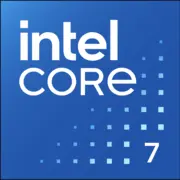Advantages
- Newer Launch Date: October 2024 (October 2024 vs January 2024)
- More Total Cores: 20 (14 vs 20)
- Higher Performance-core Max Turbo Frequency: 5.5 GHz (5.2 GHz vs 5.5 GHz)
- Larger L3 Cache: 33 MB (24 MB vs 33 MB)
- Higher Technology: Intel 7 (10 nm vs Intel 7)
Basic
Intel
Label Name
Intel
October 2024
Launch Date
January 2024
Laptop
Platform
Mobile
Core 7 250H
Model Name
?
The Intel processor number is just one of several factors - along with processor brand, system configurations, and system-level benchmarks - to be considered when choosing the right processor for your computing needs.
i7-14700HX
Raptor Lake
Code Name
Raptor Lake
Intel
Foundry
-
Core 7 (Raptor Lake)
Generation
-
CPU Specifications
14
Total Cores
?
Cores is a hardware term that describes the number of independent central processing units in a single computing component (die or chip).
20
20
Total Threads
?
Where applicable, Intel® Hyper-Threading Technology is only available on Performance-cores.
28
6
Performance-cores
8
8
Efficient-cores
12
2.5 GHz
Performance-core Base Frequency
2.1 GHz
1300 MHz
Efficient-core Base Frequency
1.5 GHz
5.2 GHz
Performance-core Max Turbo Frequency
?
Maximum P-core turbo frequency derived from Intel® Turbo Boost Technology.
5.5 GHz
4.1 GHz
Efficient-core Max Turbo Frequency
?
Maximum E-core turbo frequency derived from Intel® Turbo Boost Technology.
3.9 GHz
80 KB per core
L1 Cache
-
1.25 MB per core
L2 Cache
-
24 MB
L3 Cache
33 MB
25
Multiplier
-
Intel FCBGA 1744
CPU Socket
?
The socket is the component that provides the mechanical and electrical connections between the processor and motherboard.
FCBGA1964
No
Unlocked Multiplier
-
100 MHz
Bus Frequency
-
10 nm
Technology
?
Lithography refers to the semiconductor technology used to manufacture an integrated circuit, and is reported in nanometer (nm), indicative of the size of features built on the semiconductor.
Intel 7
15 W
TDP
55 W
-
Processor Base Power
?
The time-averaged power dissipation that the processor is validated to not exceed during manufacturing while executing an Intel-specified high complexity workload at Base Frequency and at the junction temperature as specified in the Datasheet for the SKU segment and configuration.
55 W
-
Maximum Turbo Power
?
The maximum sustained (>1s) power dissipation of the processor as limited by current and/or temperature controls. Instantaneous power may exceed Maximum Turbo Power for short durations (<=10ms). Note: Maximum Turbo Power is configurable by system vendor and can be system specific.
157 W
-
Max. Operating Temperature
?
Junction Temperature is the maximum temperature allowed at the processor die.
100°C
4
PCIe Version
?
PCI Express is a high-speed serial computer expansion bus standard used for connecting high-speed components, replacing older standards such as AGP, PCI, and PCI-X. It has gone through multiple revisions and improvements since its initial release. PCIe 1.0 was first introduced in 2002, and in order to meet the growing demand for higher bandwidth, subsequent versions have been released over time.
-
-
PCI Express Version
?
PCI Express Revision is the supported version of the PCI Express standard. Peripheral Component Interconnect Express (or PCIe) is a high-speed serial computer expansion bus standard for attaching hardware devices to a computer. The different PCI Express versions support different data rates.
5.0 and 4.0
Memory Specifications
DDR4-3200, DDR5-5200
Memory Type
?
Intel® processors come in four different types: Single Channel, Dual Channel, Triple Channel, and Flex Mode. Maximum supported memory speed may be lower when populating multiple DIMMs per channel on products that support multiple memory channels.
Up to DDR5 5600 MT/s Up to DDR4 3200 MT/s
-
Max Memory Size
?
Max memory size refers to the maximum memory capacity supported by the processor.
192 GB
2
Memory Channels
?
The number of memory channels refers to the bandwidth operation for real world application.
2
83.2 GB/s
Max Memory Bandwidth
?
Max Memory bandwidth is the maximum rate at which data can be read from or stored into a semiconductor memory by the processor (in GB/s).
-
No
ECC Memory Support
-
GPU Specifications
Iris Xe Graphics 96EU
Integrated Graphics Model
?
An integrated GPU refers to the graphics core that is integrated into the CPU processor. Leveraging the processor's powerful computational capabilities and intelligent power efficiency management, it delivers outstanding graphics performance and a smooth application experience at a lower power consumption.
Intel® UHD Graphics for 14th Gen Intel® Processors
-
Graphics Frequency
?
Graphics max dynamic frequency refers to the maximum opportunistic graphics render clock frequency (in MHz) that can be supported using Intel® HD Graphics with Dynamic Frequency feature.
1.6 GHz
Miscellaneous
8
PCIe Lanes
-
Benchmarks
Geekbench 6 Single Core
Core 7 250H
2415
Core i7-14700HX
2921
+21%
Geekbench 6 Multi Core
Core 7 250H
13201
Core i7-14700HX
17475
+32%
Passmark CPU Single Core
Core 7 250H
4321
+14%
Core i7-14700HX
3782
Passmark CPU Multi Core
Core 7 250H
31840
Core i7-14700HX
37592
+18%
Share in social media
Or Link To Us
<a href="https://cputronic.com/cpu/compare/intel-core-7-250h-vs-intel-core-i7-14700hx" target="_blank">Intel Core 7 250H vs Intel Core i7-14700HX</a>





